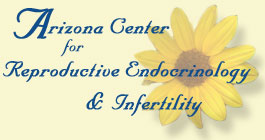


THE FEMALE REPRODUCTIVE SYSTEM
Normal anatomy and regular menstrual cycles are key factors in establishing female fertility. The female reproductive system is mainly internal. The vagina is the passage that leads from the outside of the body to the cervix, which is the opening to the uterus. The uterus is a muscular organ about the size and shape of a pear, which is lined with a rich and nourishing mucous membrane called the endometrium. The uterus is where a fertilized egg attaches itself and develops into a baby.
The ovaries are the two small structures that store the woman’s eggs. In addition to developing a mature egg during each menstrual cycle, the ovaries produce the female hormones estrogen and progesterone. Each month, only a single egg (ovum) matures inside a follicle (capsule) within an ovary. At mid cycle, the egg is released form the follicle in a process called ovulation. The egg then enters one of the fallopian tubes, traveling toward the uterus. At the end of the fallopian tube, near the uterus, the egg is ready for fertilization.
THE MENSTRUAL CYCLE
The menstrual cycle refers to the time between each monthly shedding of the endometrial lining. Each normal cycle includes the maturation and release of an egg followed by the preparation of the uterine lining to receive and nurture an embryo, the early fetal growth up through pregnancy. If a fertilized egg is not present, the uterus will shed the lining, beginning the woman’s period and the next menstrual cycle. The typical cycle takes approximately 28 to 32 days and is divided into three distinct phases:
THE FOLLICULAR PHASE
The follicular phase begins in the first day of menstrual bleeding. The pituitary gland, located at the base of the brain, begins releasing two hormones, follicle stimulating hormone (FSH), and leutinizing hormone (LH). These hormones stimulate the ovary to produce an egg (follicular growth). The developing follicle secrets the hormone estrogen, which is the primary female hormone that helps maintain female sexual characteristics. Estrogen levels rise throughout the follicular phase and eventually trigger the LH surge and ovulation. Estrogen is also responsible for midcycle changes in the cervical mucus about the time of ovulation.
THE OVULATORY PHASE
The ovulatory phase begins when the levels of LH surge causing the follicle to rupture and the egg to be released from the ovary. The fringed and hairlike outer ends of the fallopian tube called the fimbria sweep over the ovary and move the egg into the tube. A change in cervical mucus occurs as a result of estrogen produced in the follicular phase. The mucus becomes more abundant, clear and watery, which enables sperm to travel easily through it to reach the egg.
THE LUTEAL PHASE
The luteal phase begins after ovulation occurs. During the luteal phase, the follicle that released the egg becomes a functioning gland called the corpus luteum. The corpus luteum produces progesterone, which prepares the uterus with the rich lining needed for implantation
FERTILIZATION
Fertilization requires that intercourse take place during midcycle. Sperm travel up through the female reproductive tract to meet the egg. For fertilization to occur, the ovum, or egg, must meet with the sperm at the end of the fallopian tube. The fertilized egg (now called the embryo) moves into the uterus. Once inside the uterus, the embryo implants into the lush lining on or about the 20th day of the cycle. If fertilization occurs, the corpus luteum detects the pregnancy and continues to produce progesterone, thus preserving the uterine lining and pregnancy. If fertilization does not occur, the corpus luteum will cease to function on about Day 26. The uterine lining will then break down and be shed several days later, starting the next menstrual period.
THE MALE REPRODUCTIVE SYSTEM
The male reproductive system is both internal and external. The testes are located within the scrotal sac, the fleshy pouch of skin located below the manÕs penis. The testes produce sperm and testosterone, the primary male hormone that helps maintain the male sexual characteristics. As sperm are produced, they pass from the testes through the coiled channels of the epidiymis, which stores and nourishes them as they mature. The mature sperm then move into the vas deferens, the tubal structure that transports sperm from the epididymis to the seminal vesicles. The seminal vesicles and the prostate gland both empty fluids combine with the sperm to produce semen, which is ejaculated during intercourse. The pituitary hormones, FSH and LH, are responsible for maintaining the sperm production process. These are the same hormones necessary for regulating the female’s reproductive functions. FSH is responsible for stimulating sperm production in the testicles, and LH stimulates the production of testosterone. Immature sperm cells develop through several stages to become mature sperm cells. As the sperm pass through the epidiymis, they gain motility (movement). This process takes about 18 to 24 hours, after which they are stored in the vas deferens awaiting ejaculation. The entire process of sperm maturation takes about 72 days. However, this is an ongoing process and millions of sperm are being manufactured all the time.
Several factors determine whether a man’s sperm can fertilize an egg:
- Volume of semen
- Sperm count or density
- Sperm motility
- Forward progression
- Sperm shape
Although sperm count is critical, sperm motility and forward progression appears to be the more important factors in determining the fertilizing capability of sperm. Despite a low sperm count, many men with high-quality (viable and highly motile) sperm may still be fertile. The Importance of Timing For most couples, the probability of pregnancy occurring in any one month is only about 20%. There are several days each month during which conception is possible. The best time for intercourse is midcycle, during ovulation. At this time, the egg is positioned in the fallopian tube and remains there for about 24-48 hours, awaiting fertilization by the man’s sperm. Sperm can live 48 to 72 hours within the female reproductive tract. However, even in a perfectly timed cycle, pregnancy does not always occur. There may be several reasons for this, including the fact that some eggs don’t fertilize and some of the fertilized eggs don’t develop well in the early stages.
Arizona Center for Reproductive Endocrinology and Infertility
Caring for you, Caring for your heath & Caring for your future
5190 E Farness Drive #114 Tucson, Arizona 85712
(520) 326-0001